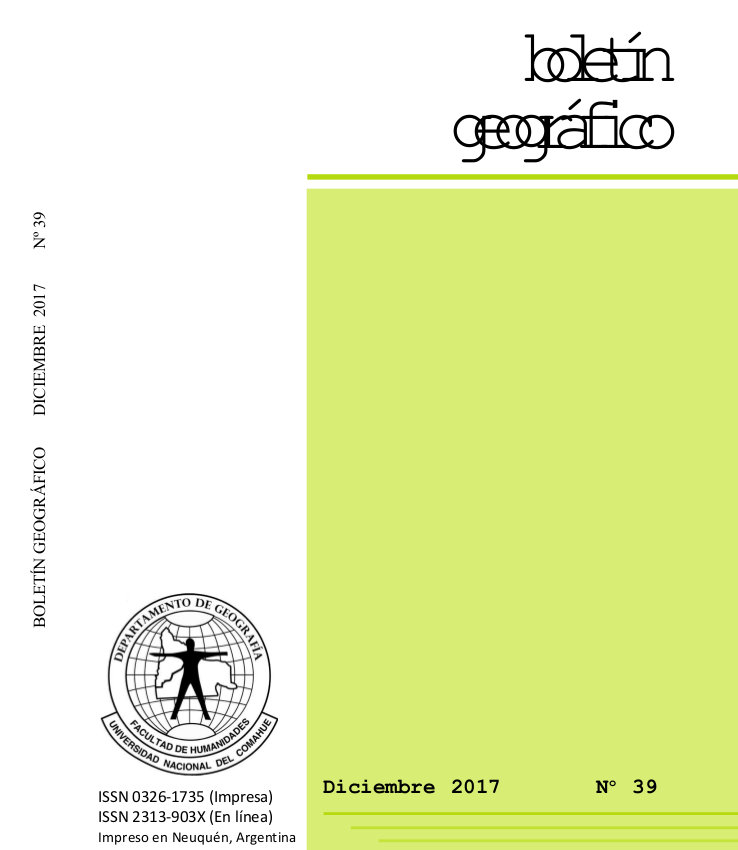Application of the factorial analysis to specially Discriminate geographic variables
Keywords:
Factorial analysis, precipitation, spatial-temporal discriminationAbstract
This work aims to show the effectiveness of Factor Analysis in geographic research, explaining how to discriminate spatially to any geographic variable, which in this case; Is the precipitation in the Argentine Republic and Chile, taking into account its interannual variability, This task was carried out applying this multivariate methodology, given its recognized validity to find the underlying
structures in a high number of variables.
The spatial discrimination of a variable is important to analyze the processes involved, taking into account homogeneous areas from the point of view of its geographical distribution and its genesis, Understanding the behavior of such uniform areas, the geographer can perform an adequate planning of that scenario.
The additional purpose of this investigation is to provide a contribution to the understanding of the regime of the interannual variability of rainfall in the Argentinean and Chilean territory analyzed from a sandy point of view. With the application of this methodology, eight domains with spatial uniformity were identified in the variability of the mean annual precipitation, from the same number of factors, which explain 61% of the variance. The criterion adopted in the definitive retention of these eight factors is that they follow a pattern of territorial homogeneity, since they condense with enough spatial discrimination the information contained in the ninety-five original variables.
Downloads
References
Almeira, G., Ciappesoni, H. y Goniadzki D. (2009) Algunos aspectos de la precipitación regionalizada en el centro-norte de Argentina. Preprint Congremet, Buenos Aires, Argentina.
Barros, V., Moyra. (1996). Precipitation trends in Southern America to the East of the Andes, Centre of Ocean Land Atmospheric Studies, COLA, MD, Report No26. Proceeding of the Workshops of Dynamics on Statistical of Secular Climate
Variations, 76-80.
Bruniard, E. (1989) NA ́ ALHUA, Instituto de Geografía, UNNE- Chaco.
Chan, S., Behera, S., & Yamagata, T. (2008). Indian Ocean Dipole influence on South American rainfall. Geophysical Research Letters, 35(14). Retomado de:
http://dx.doi.org/10.1029/2008gl034204
Grupo Chadule: " Métodos estadísticos en Geografía", Ed, El Cano, 1000, Madrid
Hoffman, José A. (1989). Las variaciones climáticas ocurridas en la Argentina desde fines del siglo pasado hasta el presente. El Deterioro del Ambiente en la Argentina. Divulgación No 15 del Servicio Meteorológico Nacional. FECIC, Bs.As. http://dx.doi.org/10.1175/1520-0442(2000)013<1000:amitec>2.0.co;2
Jennrich, R., & Robinson, S. (1969). A Newton-Raphson algorithm formaximum likelihood factoanalysis. Psychometrika, 34(1), 111-123. http://dx.doi.org/10.1007/bf02290176
Joereskog K,G. (1976) Factor analysis by least-squares and maximum-likelihood methods. Statistical Methods for Digital Computers. p125-153. Eds. In Enslein, K,, Ralston, A, and Wilf, H,S. Wiley.
Johnson, R., & Wichern, D. (1988). Applied multivariate statistical analysis. Englewood Cliffs, New Jersey: Prentice-Hall.
Minetti, J,L, y W. Vargas. (1998). Trends and jumps in the annual precipitation in South America, south of the 15oS. Atmósfera 11, No4, 205-223, México.
Morrison, D. (1982). Multivariate statistical methods. New York, (etc): Mac Graw-Hill.
Poblete, A. G. y Bertol E. (2001). Variabilidad internanual del derrame anual del río San Juan, IGA Revista de Geografía, No: 5. Instituto y Departamento de Geografía, FFHA-UNSJ. San Juan, Argentina.
Poblete, A. G., Minetti, J, L. (2003). Asociación entre cuantificadores del ENSO e índices de circulación atmosférica regional con el derrame del río San Juan. IGA Revista de Geografía, Vol,:7 año 6, Páginas 26-33. Instituto y Departamento de Geografía, FFHA-UNSJ. San Juan, Argentina.
Poblete, A. G., Minetti, J.L, Sánchez, G. DEL V. (2001). Análisis de la variabilidad interanual de los ríos andinos de Cuyo y del Comahue con métodos multivariantes. Libro electrónico del IX Congreso Latinoamericano e Ibérico de
Meteorología y VIII Congreso Argentino de Meteorólogos. Buenos Aires, Reboita, M., Ambrizzi, T., & Rocha, R. (2009). Relationship between the southern annular mode and southern hemisphere atmospheric systems. Revista Brasileira De Meteorologia, 24(1), 48-55.
Saji, N., Goswami, B., Vinayachandran, P., & Yamagata, T. (1999). A dipole mode in the tropical Indian Ocean. Nature, 401(6751), 360-363: http://dx.doi.org/10.1038/43854
Silvestri, G. (2003). Antarctic Oscillation signal on precipitation anomalies over southeastern South America. Geophysical Research Letters, 30(21).: http://dx.doi.org/10.1029/2003gl018277
Tatsouda M.N. (1971). Multivariate Analysis, Wiley, New York. Thompson, D., & Wallace, J. (2000). Annular Modes in the Extratropical Circulation. Part I: Month-to-Month Variability*. Journal Of Climate, 13(5), 1000-1016.
Published
How to Cite
Issue
Section
License
Copyright (c) 2017 Boletin GeográficoTransfer of rights and data processing
The acceptance of an article for publication in the Journal Geographic Bulletin implies the cession of the rights of printing and reproduction, by any means and means, of the author in favor of the Department of Geography of the National University of Comahue, which will not reject any request reasonable for the authors to obtain permission to reproduce their contributions. The total or partial reproduction of the works published in the Geographic Bulletin must be done citing the origin, otherwise, the copyright is violated.
Likewise, it is understood that the concepts and opinions expressed in each work are the sole responsibility of the author, without being responsible or in solidarity, necessarily, neither the editorial staff nor the editorial staff.
It is the responsibility of the authors to be able to provide interested readers with copies of the raw data, procedure manuals, scores and, in general, relevant experimental material.
Likewise, the Management of the journal guarantees the appropriate treatment of personal data
COPYRIGHT TRANSFER FORM


















 Journal of the
Journal of the 